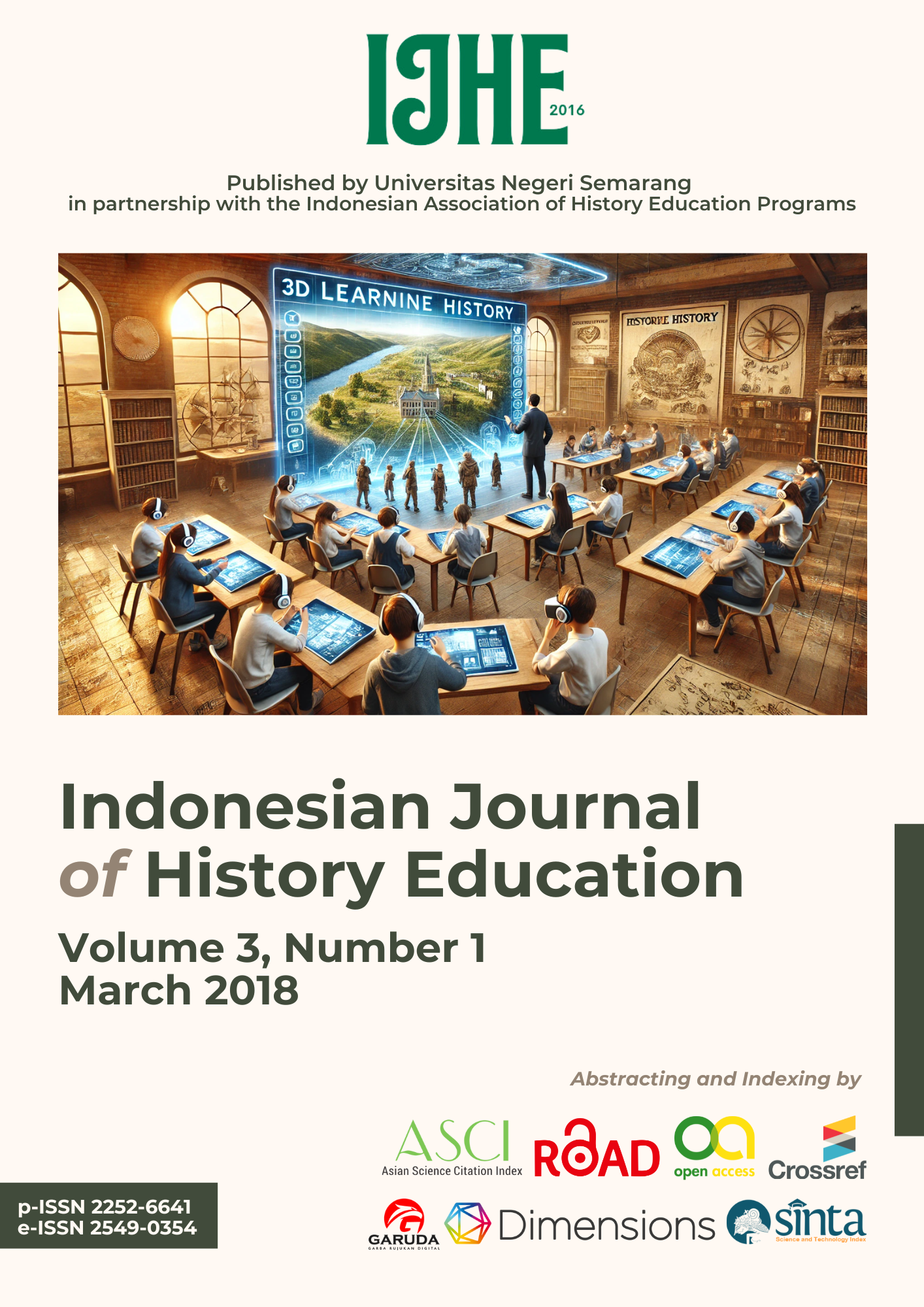Utilization of Audio Visual Media as a Source History Learning
Abstract
The research problem is centered on applying audiovisual media in teaching history, specifically within the history learning class of XI students at High School 2 Holy Bae during the academic year 2013/2014. This investigation seeks to explore whether the utilization of audiovisual media in teaching history has a significant impact on the learning outcomes of these students. The study aims to assess the effectiveness of audiovisual media in enhancing the student's understanding and retention of historical knowledge. Furthermore, it intends to measure how much audiovisual media influences the overall learning outcomes of class XI students at High School 2 Holy Bae during the 2013/2014 academic year. The study will provide insights into the benefits and challenges of integrating audiovisual media into history education by focusing on these objectives. Additionally, the research will offer educators recommendations on effectively incorporating such media to improve student engagement and academic performance. The primary goals of this study are to evaluate the use of audiovisual media-based teaching methods in history education, to determine the learning outcomes of class XI students, and to analyze the impact of audiovisual media on the academic achievements in the history subjects of class XI Social at High School 2 Bae Kudus. This comprehensive investigation aims to contribute to the broader field of educational media and its application in enhancing history education's teaching and learning processes.
References
Anni, C. T. (2004). Psikologi belajar. UNNES.
Arikunto, S. (2006). Prosedur penelitian: Suatu pendekatan praktik (Edisi Revisi IV). PT Rineka Cipta.
Arikunto, S. (2014). Prosedur Penelitian: Suatu Pendekatan Praktik. Rineka Cipta.
Arsyad, A. (2013). Media Pembelajaran. Raja Grafindo Persada.
Badrika, I. W. (2006). Sejarah untuk SMA jilid II kelas XI IPS. Erlangga.
Darsono, M. (2000). Belajar dan pembelajaran. IKIP Semarang Press.
Dimyati, & Mudjiono. (1994). Belajar dan pembelajaran. Rineka Cipta.
Djamarah, S. B. (2010). Belajar mengajar. Rineka Cipta.
Hamalik, O. (1994). Media pendidikan. Alumni.
Isjoni. (2013). Strategi Pembelajaran Efektif. Bumi Aksara.
Kasmadi, H. (2001). Pengembangan Pembelajaran dengan Pendekatan Model-Model Pengajaran Sejarah. Semarang: PT. Prima Nugraha Pratama.
Miftah, M. (2014). Pemanfaatan media pembelajaran untuk peningkatan kualitas belajar siswa. Kwangsan: Jurnal Teknologi Pendidikan, 2(1), 1-12.
Munadi, Y. (2010). Media Pembelajaran. Gaung Persada Press.
Nasution, S. (2016). Metode Research: Penelitian Ilmiah. Bumi Aksara.
Poerwadarminta, W. J. S. (Ed.). (1965). Kamus umum bahasa Indonesia. Balai Pustaka.
Prastawa, A. (2011). Panduan kreatif membuat bahan ajar inovatif. Diva Press.
Purwadarminta. (1984). Kamus besar bahasa Indonesia. Depdikbud.
Purwanto. (2016). Media dan Sumber Belajar dalam Pendidikan. Pustaka Pelajar.
Sadiman, A. (dkk). (2009). Media pendidikan: Pengertian, pengembangan dan pemanfaatannya. Rajawali Pers.
Sanjaya, W. (2006). Strategi pembelajaran berorientasi standar proses pendidikan. Prenada Media Grup.
Sanjaya, W. (2009). Media Komunikasi Pembelajaran. Kencana Prenada Media Group.
Sudijono, A. (2006). Pengantar evaluasi pendidikan. PT Raja Grafindo Persada.
Suprijono, A. (2009). Cooperative learning: Teori dan aplikasi PAIKEM. Pustaka Pelajar.
Supriyadi. (2015). Inovasi dalam Pembelajaran. Remaja Rosdakarya.
Syukur, F. (2008). Teknologi pendidikan. Raisal Media Group.
Copyright (c) 2018 Indah Ayu Ainina

This work is licensed under a Creative Commons Attribution 4.0 International License.
Copyright Notice
An author who publishes in the Jurnal Indonesian Journal of History Education agrees to the following terms:
- Author retains the copyright and grants the journal the right of first publication of the work simultaneously licensed under the Creative Commons Attribution-ShareAlike 4.0 License that allows others to share the work with an acknowledgement of the work's authorship and initial publication in this journal
- Author is able to enter into separate, additional contractual arrangements for the non-exclusive distribution of the journal's published version of the work (e.g., post it to an institutional repository or publish it in a book) with the acknowledgement of its initial publication in this journal.
- Author is permitted and encouraged to post his/her work online (e.g., in institutional repositories or on their website) prior to and during the submission process, as it can lead to productive exchanges, as well as earlier and greater citation of the published work (See The Effect of Open Access).
Read more about the Creative Commons Attribution-ShareAlike 4.0 Licence here: https://creativecommons.org/licenses/by-sa/4.0/.




